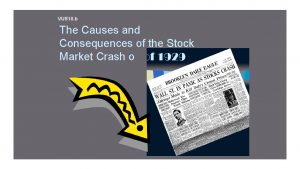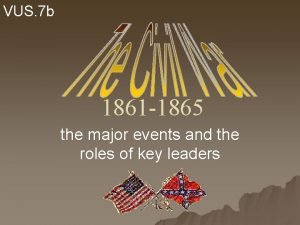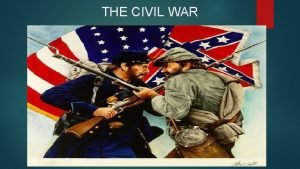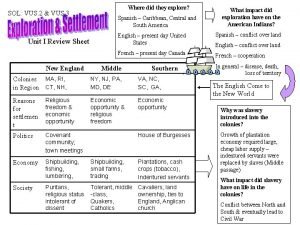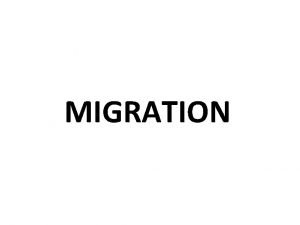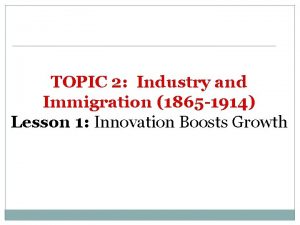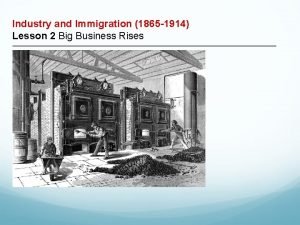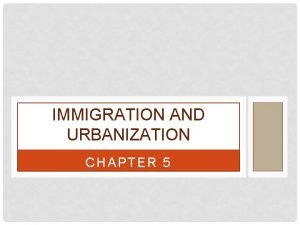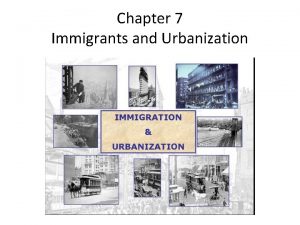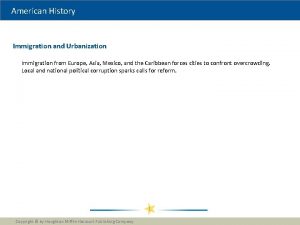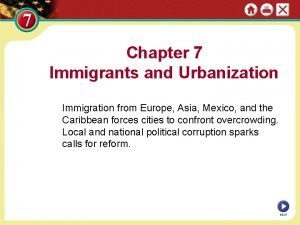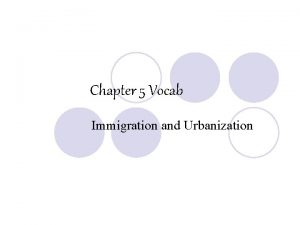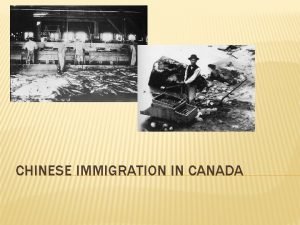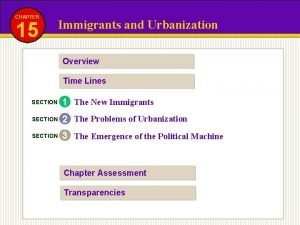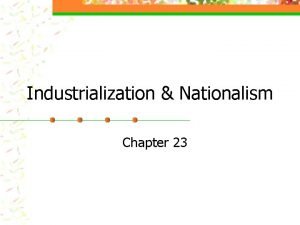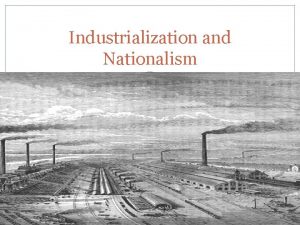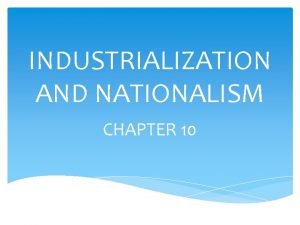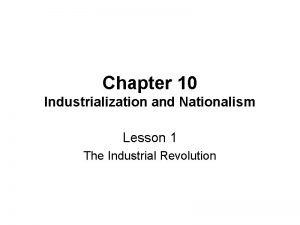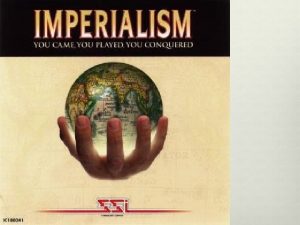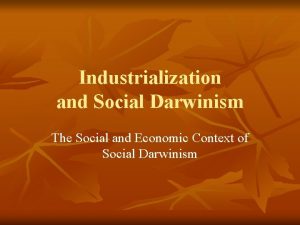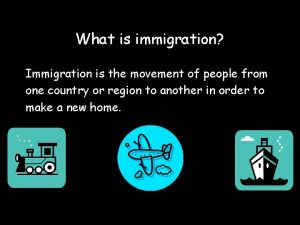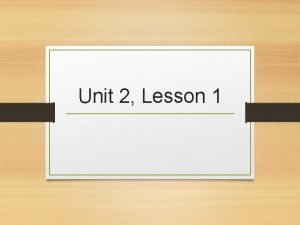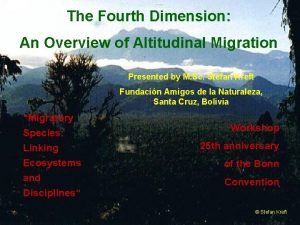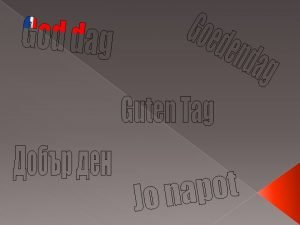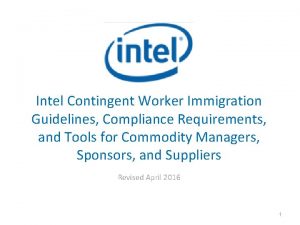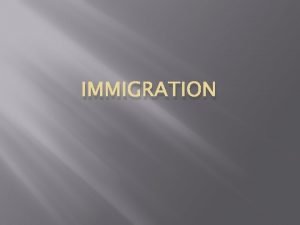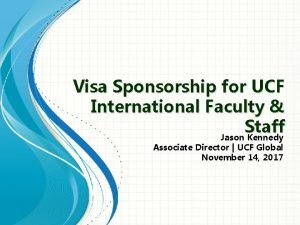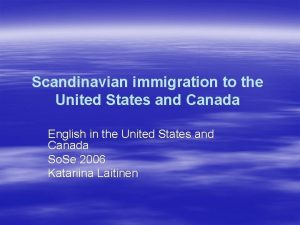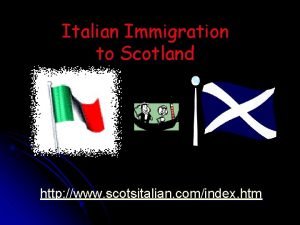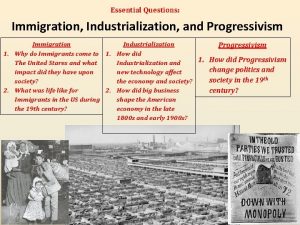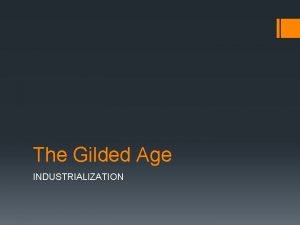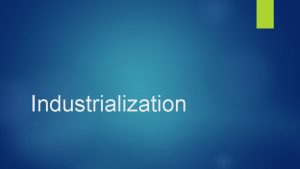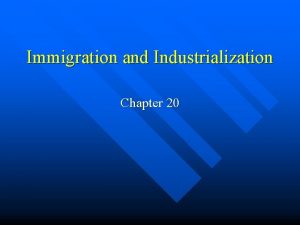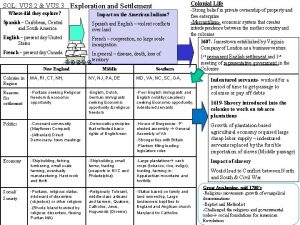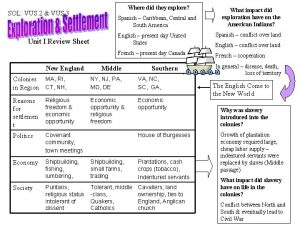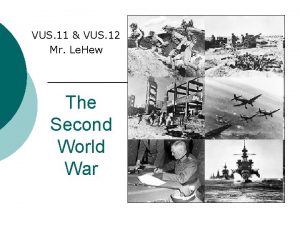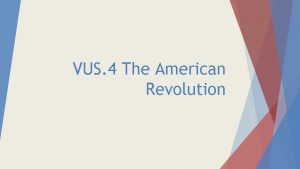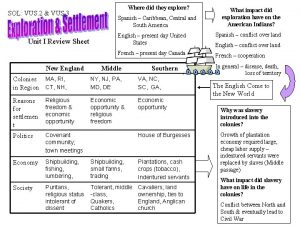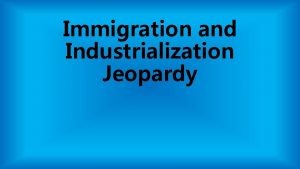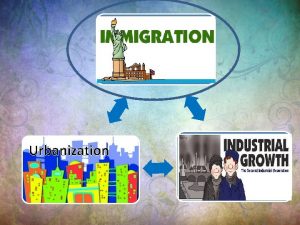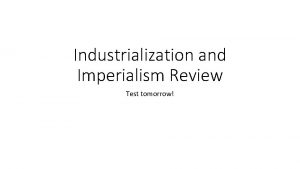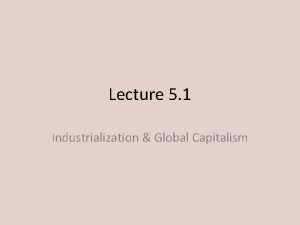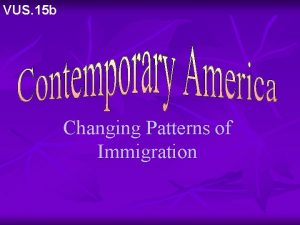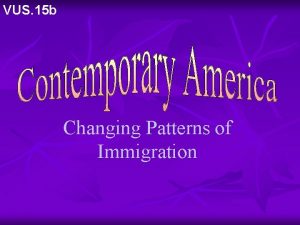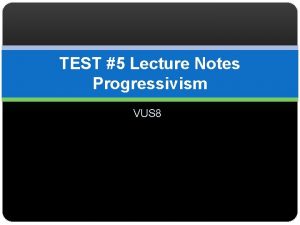Industrialization and Immigration VUS 8 TEST 4 LECTURE







































- Slides: 39

Industrialization and Immigration VUS. 8 TEST #4 LECTURE NOTES

Settling the West After Civil War, settlement - Mississippi River to Pacific Ocean American cowboy, long cattle drives for hundreds of miles over unfenced open land Homestead Act 1862 Gave 160 acres of free land if you lived and improved it over a 5 year period Morrill Land Grant Act Gave land foreducational institutions that taught agriculture and mechanic arts Virginia Tech


Settling the West Transcontinental Railroad opened up vast regions of the North American heartland for settlement Linked the Union Pacific in the east to the Central Pacific in the west –Promontory Point, Utah Chinese and Irish labor

Transcontinental Railroad


Settling the West New technologies - farming profitable Railroad Land grants – private R. R. Mechanical Reaper Cyrus Mc. Cormick A horse drawn machine – increases output



Immigration Prior to 1871, most immigrants from northern and western Europe (Germany, Great Britain, Ireland, Norway, and Sweden) 1871 until 1921, most immigrants from southern and eastern Europe (Italy, Greece, Poland, Russia, present-day Hungary, and former Yugoslavia), also Asia (China and Japan)

Immigration 1. ) Push Factors (Reasons why people left their native lands) Religious and political persecution Looking for a better opportunity Relaxed immigration laws in their own nation

Immigration 2. ) Pull Factors (reasons to come to the US) Freedoms – religious and political Family and friends that lived in the US Land Cheap labor for developing industry �Industrialists recruitment

Immigration and Industrialization Jewish Immigrants Clothing industry in New York City Chinese Immigrants Mines and Railroads Irish Immigrants Building and construction industries Slavs, Poles, and Italians Coal mines of West Virginia and Pennsylvania

Contributions of Immigrants Food—Italian food, Chinese food, Irish Pubs Language—Chinese, Yiddish, Italian, Slavic Music Dress

Contributions of Immigrants Irving Berlin Russian Composer Wrote “God Bless America” and “White Christmas”

Contributions of Immigrants Enrico Fermi Italian Physicist – split the atom creating nuclear power

Contributions of Immigrants Albert Einstein German Atomic theory Theory of Relativity Sent letters to FDR warning of Nazi work Atomic bomb

“Melting Pot”—Assimilation of Immigrants to the US Problems facing immigrants Prejudices - race, language, and religion Lack of housing The language barrier Feared - take jobs for lower pay Know Nothing Party Opposed immigrants especially the Irish Catholics

Nativists--people against immigration— claimed that the immigrants’ language, customs, and ideas upset the American way of life -took jobs – “we don’t hire Irish” -threat to democracy Ellis Island New York Harbor Statue of Liberty immigrant receiving station


Legislation limiting immigration Chinese Exclusion Act (1882) Banned Chinese immigration to the US for 10 years Immigration Restriction Act (1921) Created a quota system - restricts immigration except Northwest Europe

Urbanization—the Growth of Cities Chicago, Detroit, Cleveland, Pittsburgh, and New York grew from manufacturing and transportation centers provided jobs harsh conditions – tenements Pollution Waste thrown in streets Lack of sewage – Disease Violence – lack of police New York City - Subway system Trolley system - Richmond, VA



Political Machines Political machines Created to win votes – “did favors” Did provide services especially for immigrants Tammany Hall – New York City

Industrial Revolution Electricity—Light Bulb—Thomas Edison Bessemer Process—Henry Bessemer Method of making cheaper steel Assembly Line— Pioneered by Henry Ford -cars became more affordable Airplane—Wright Brothers First powered flight Telephone—Alexander Graham Bell Communication over long distances Railroads—Cornelius Vanderbilt transport raw materials and finished goods

Thomas Edison

Henry Bessemer

Henry Ford

Wright Brothers Video

Alexander Graham Bell

Horizontal vs. Vertical Integration Advantages of creating corporations Limited Liability If a corporation fails, shareholders normally only stand to lose their investments – Not liable otherwise Raising Capital Allows company to create more money by borrowing or selling more stock

Horizontal vs. Vertical Integration 1. ) Horizontal Integration: A company merges or buys all of the other competing companies Used by Rockefeller Single company controls one particular part of industry – A MONOPOLY 2. ) Vertical Integration: Company control all aspects of production—from the acquisition of raw materials to the final delivery of the product Used by Carnegie

Trusts and Laissez-Faire Economics A Trust - combination of companies that dominate an industry Laissez-faire economics Doing business without any government interference or regulation

1. ) Andre Carnegie Poor Scottish immigrant Steel industry Bought up coal mines and iron ore deposits purchased railroads and ships to transport the raw materials and send the materials to market Controlled every aspect of the steel production

Andrew Carnegie

2. ) John D. Rockefeller refined kerosene from petroleum Standard Oil Company Tried to purchase all competing oil companies Standard Oil controlled most of America’s oil industry

3. ) J. P. Morgan 1901: Morgan purchased Carnegie’s steel company Created U. S. Steel Controlled banking J. P. Morgan

4. ) Cornelius Vanderbilt Controlled the railroad industry
 Greyhound vus
Greyhound vus Vus.10b when was the stock market crash?
Vus.10b when was the stock market crash? Vus 7a what event sparked secession of the southern states?
Vus 7a what event sparked secession of the southern states? Vus 7b when did the civil war officially begin?
Vus 7b when did the civil war officially begin? Vus review
Vus review 01:640:244 lecture notes - lecture 15: plat, idah, farad
01:640:244 lecture notes - lecture 15: plat, idah, farad Difference between immigration and emigration
Difference between immigration and emigration Topic 2 industry and immigration
Topic 2 industry and immigration Industry and immigration lesson 2
Industry and immigration lesson 2 Industry and immigration lesson 2
Industry and immigration lesson 2 Chapter 5 immigration and urbanization
Chapter 5 immigration and urbanization Chapter 7 building vocabulary immigration and urbanization
Chapter 7 building vocabulary immigration and urbanization Chapter 7 building vocabulary immigration and urbanization
Chapter 7 building vocabulary immigration and urbanization Transcontinent
Transcontinent Chapter 7 building vocabulary immigration and urbanization
Chapter 7 building vocabulary immigration and urbanization Chapter 5 immigration and urbanization
Chapter 5 immigration and urbanization Chinese immigration to canada push and pull factors
Chinese immigration to canada push and pull factors Chapter 15 building vocabulary immigration and urbanization
Chapter 15 building vocabulary immigration and urbanization Lesson quiz 23-2 industrialization and nationalism answers
Lesson quiz 23-2 industrialization and nationalism answers Chapter 10 industrialization and nationalism
Chapter 10 industrialization and nationalism -have strength to match the growth of industrialization
-have strength to match the growth of industrialization Chapter 10 lesson 1 the industrial revolution
Chapter 10 lesson 1 the industrial revolution Imperialism and industrialization
Imperialism and industrialization Social darwinism in the industrial revolution
Social darwinism in the industrial revolution What is the immigration
What is the immigration What is immigration
What is immigration How did esperanza help marta during an immigration sweep
How did esperanza help marta during an immigration sweep Fourth dimension immigration
Fourth dimension immigration Interregional migration definition ap human geography
Interregional migration definition ap human geography Emmigration definition
Emmigration definition Intel contingent worker salary
Intel contingent worker salary Emigrant v immigrant
Emigrant v immigrant Http://teacher.scholastic.com/activities/immigration/tour/
Http://teacher.scholastic.com/activities/immigration/tour/ Klasko immigration law partners, llp
Klasko immigration law partners, llp European immigration to texas
European immigration to texas Christina khan ucf
Christina khan ucf Immigration to the united states
Immigration to the united states Jennie ellis australia immigration
Jennie ellis australia immigration Italian immigration to scotland
Italian immigration to scotland Frank & delaney immigration law, llc
Frank & delaney immigration law, llc

